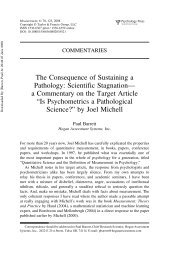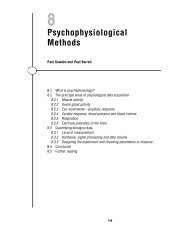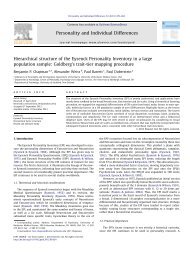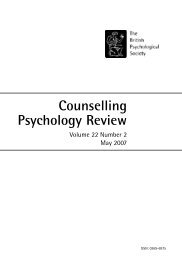Dimensions of variation on the CORE-OM - Paul Barrett
Dimensions of variation on the CORE-OM - Paul Barrett
Dimensions of variation on the CORE-OM - Paul Barrett
You also want an ePaper? Increase the reach of your titles
YUMPU automatically turns print PDFs into web optimized ePapers that Google loves.
Copyright © The British Psychological SocietyReproducti<strong>on</strong> in any form (including <strong>the</strong> internet) is prohibited without prior permissi<strong>on</strong> from <strong>the</strong> Society<str<strong>on</strong>g>Dimensi<strong>on</strong>s</str<strong>on</strong>g> <str<strong>on</strong>g>of</str<strong>on</strong>g> <str<strong>on</strong>g>variati<strong>on</strong></str<strong>on</strong>g> <strong>on</strong> <strong>the</strong> <strong>CORE</strong>-<strong>OM</strong> 189matrix comparis<strong>on</strong> results, <strong>the</strong>se models would be fit to ei<strong>the</strong>r separate gender matricesor <strong>the</strong> total sample matrix <str<strong>on</strong>g>of</str<strong>on</strong>g> 2,140 cases.The first model tested was <strong>the</strong> established <strong>CORE</strong>-<strong>OM</strong> model and this was <strong>the</strong>nsystematically varied in terms <str<strong>on</strong>g>of</str<strong>on</strong>g> alternative c<strong>on</strong>ceptualizati<strong>on</strong>s <str<strong>on</strong>g>of</str<strong>on</strong>g> <strong>the</strong> <strong>CORE</strong>-<strong>OM</strong>structure. This model-testing process is designed as a comprehensive series <str<strong>on</strong>g>of</str<strong>on</strong>g> testswhose aim is to try to establish <strong>the</strong> optimum psychometric factor model for <strong>CORE</strong>-<strong>OM</strong>.All SEM analyses were c<strong>on</strong>ducted using both SPSS AMOS-5 (Arbuckle, 2003) andSTATISTICA SEPATH s<str<strong>on</strong>g>of</str<strong>on</strong>g>tware, to provide an internal check <strong>on</strong> modelling setup andspecificati<strong>on</strong>s, as well as <strong>the</strong> calculati<strong>on</strong> <str<strong>on</strong>g>of</str<strong>on</strong>g> <strong>the</strong> McD<strong>on</strong>ald (1989) N<strong>on</strong>-centrality Indexwithin SEPATH. SEM analyses were undertaken <strong>on</strong> covariance matrices in AMOS, withoutput expressed in standardized form (which corresp<strong>on</strong>ds to <strong>the</strong> completelystandardized soluti<strong>on</strong> in SEPATH). Five indices were used to gauge goodness-<str<strong>on</strong>g>of</str<strong>on</strong>g>-fit <str<strong>on</strong>g>of</str<strong>on</strong>g>each model-implied covariance matrix to <strong>the</strong> sample covariance matrix. These were <strong>the</strong>chi-squared exact-fit test, and four close-fit tests comprising <strong>the</strong> McD<strong>on</strong>ald n<strong>on</strong>-centralityindex (Mc), Steiger and Lind’s (1980) root mean squared error <str<strong>on</strong>g>of</str<strong>on</strong>g> approximati<strong>on</strong>(RMSEA), Bentler’s (1990) comparative fit index (CFI), and <strong>the</strong> standardized root meansquare residual index (SRMR). The chi-squared alpha for null-hypo<strong>the</strong>sis testing was setat .05. Suggested minimum values indicating acceptable model-fit for <strong>the</strong> close-fit testindices were taken from Hu and Bentler (1999). These were .90 or greater for Mc, .06 orless for RMSEA, .95 or greater for CFI, and .08 or less for SRMR.General factor models for <strong>CORE</strong>-<strong>OM</strong> were tested using <strong>the</strong> nested factors model(Gustafss<strong>on</strong> & Balke, 1993). This is a method <str<strong>on</strong>g>of</str<strong>on</strong>g> determining <strong>the</strong> extent to which eachfirst-order latent variable can be c<strong>on</strong>sidered causal for <strong>the</strong> co<str<strong>on</strong>g>variati<strong>on</strong></str<strong>on</strong>g> between a group<str<strong>on</strong>g>of</str<strong>on</strong>g> manifest variable resp<strong>on</strong>ses; this co<str<strong>on</strong>g>variati<strong>on</strong></str<strong>on</strong>g> is modelled as independent from <strong>the</strong>causal influence <str<strong>on</strong>g>of</str<strong>on</strong>g> a hypo<strong>the</strong>sized general first-order latent variable. In essence, eachlatent variable is ‘residualized’ with respect to <strong>the</strong> general factor latent (i.e. is orthog<strong>on</strong>alto it).Difference in goodness-<str<strong>on</strong>g>of</str<strong>on</strong>g>-fit between models was tested using <strong>the</strong> chi-squared test.ResultsGender matrix comparis<strong>on</strong>The results <str<strong>on</strong>g>of</str<strong>on</strong>g> <strong>the</strong> analysis comparing <strong>the</strong> two <strong>CORE</strong>-<strong>OM</strong> correlati<strong>on</strong> matrices from maleand female resp<strong>on</strong>dents for homogeneity <str<strong>on</strong>g>of</str<strong>on</strong>g> coefficients yielded a chi-squared goodness<str<strong>on</strong>g>of</str<strong>on</strong>g>-fitstatistic <str<strong>on</strong>g>of</str<strong>on</strong>g> 819.06, df ¼ 561, p , :0001, which indicated an exact-fit rejecti<strong>on</strong> <str<strong>on</strong>g>of</str<strong>on</strong>g><strong>the</strong> null hypo<strong>the</strong>sis <str<strong>on</strong>g>of</str<strong>on</strong>g> no-difference. However, <strong>the</strong> close-fit index <str<strong>on</strong>g>of</str<strong>on</strong>g> RMSEA was .019,with 90% c<strong>on</strong>fidence interval between .016 and .022, and SRMR ¼ .031. The largeststandardized residual correlati<strong>on</strong> was just .035. This value, al<strong>on</strong>g with <strong>the</strong> informati<strong>on</strong>from <strong>the</strong> close-fit tests, indicated that <strong>the</strong> two gender matrices might reas<strong>on</strong>ably bec<strong>on</strong>sidered homogeneous, given we are c<strong>on</strong>tent to accept that <strong>the</strong> largest observeddiscrepancy between <strong>the</strong> residual correlati<strong>on</strong>s is as low as .035. The mean standardizedresidual correlati<strong>on</strong> discrepancy is .001. Therefore, both male and female datasets werecombined into a total sample dataset <str<strong>on</strong>g>of</str<strong>on</strong>g> N ¼ 2; 140, which was used in all subsequentanalyses.Domain score correlati<strong>on</strong>s and scale qualityA Pears<strong>on</strong>’s product moment correlati<strong>on</strong> matrix was calculated for <strong>the</strong> sums <str<strong>on</strong>g>of</str<strong>on</strong>g> scoresfor each <str<strong>on</strong>g>of</str<strong>on</strong>g> <strong>the</strong> four <strong>CORE</strong>-<strong>OM</strong> domains for all 2,140 cases. All correlati<strong>on</strong>s in Table 1 aresignificant at p , :0001.












